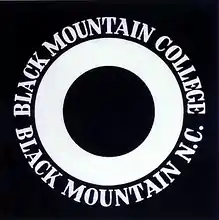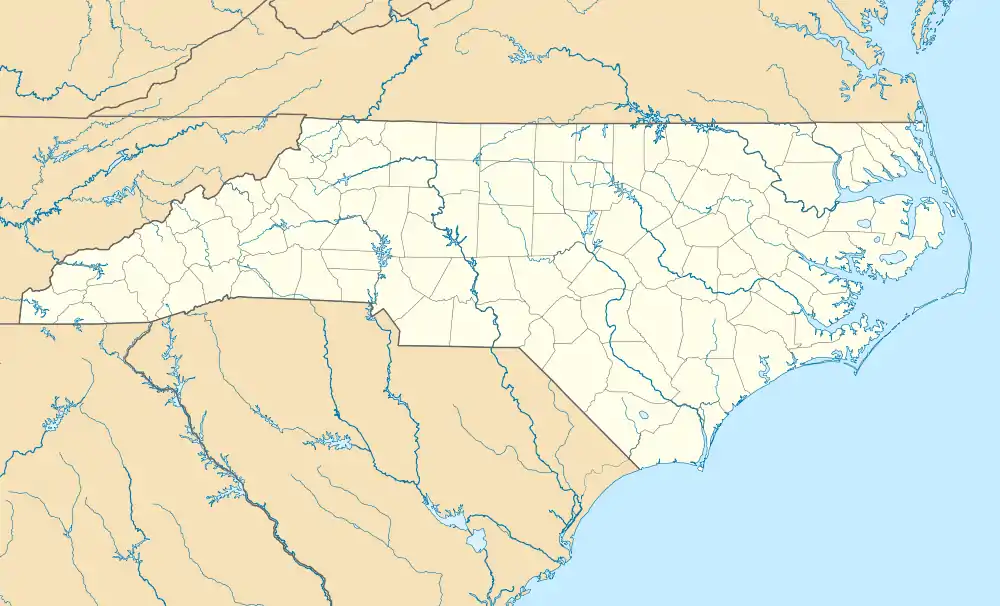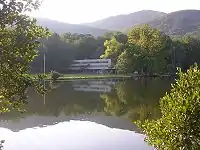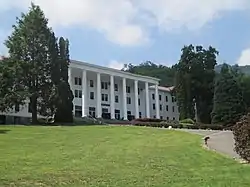Black Mountain College
Black Mountain College was a private liberal arts college in Black Mountain, North Carolina. It was founded in 1933 by John Andrew Rice, Theodore Dreier, and several others. The college was ideologically organized around John Dewey's educational philosophy, which emphasized holistic learning and the study of art as central to a liberal arts education.[2] Many of the college's faculty and students were or would go on to become highly influential in the arts, including Josef and Anni Albers, Ruth Asawa, John Cage, Robert Creeley, Merce Cunningham, Max Dehn, Elaine de Kooning, Willem de Kooning, Buckminster Fuller, Walter Gropius, Ray Johnson, Franz Kline, Robert Motherwell, Charles Olson, Robert Rauschenberg, Mary Caroline Richards, Dorothea Rockburne, Michael Rumaker, Aaron Siskind and Cy Twombly. Although it was quite notable during its lifetime, the school closed in 1957 after 24 years due to funding issues; Camp Rockmont for Boys now sits on the campus' site. The history and legacy of Black Mountain College are preserved and extended by the Black Mountain College Museum + Arts Center, located in downtown Asheville, North Carolina.[3]
 | |
| Type | Private liberal arts college |
|---|---|
| Active | 1933–1957 |
| Director | John Andrew Rice (until 1940) |
Administrative staff | about 30 |
| Students | about 1,200 total |
| Location | , , |
| Website | blackmountaincollege |
 | |
Black Mountain College Historic District | |
  | |
| Nearest city | Black Mountain, North Carolina |
| Area | 586.9 acres (237.5 ha) |
| Built | 1923 |
| Architectural style | Bungalow, craftsman, International Style |
| NRHP reference No. | 82001281[1] |
| Added to NRHP | October 5, 1982 |
.jpg.webp)
History
Black Mountain was founded in 1933 by John Andrew Rice, Theodore Dreier, Frederick Georgia, and Ralph Lounsbury, who were dismissed as faculty from Rollins College in a seminal academic freedom incident, specifically for refusing to sign a loyalty pledge, for which Rollins was formally censured by the American Association of University Professors.[4] The institution was established to "avoid the pitfalls of autocratic chancellors and trustees and allow for a more flexible curriculum," and "with the holistic aim 'to educate a student as a person and a citizen.'"[5] The school was originally funded through a $10,000 gift from "Mac" Forbes, a former Rollins College faculty member, after the founders were unable to raise funds from traditional sources.[6]:7
Black Mountain was experimental in nature and committed to an interdisciplinary approach, prioritizing art-making as a necessary component of education and attracting a faculty and lecturers that included many of America's leading visual artists, composers, poets, and designers.[2] During the 1930s and 1940s the school flourished, becoming well known as an incubator for artistic talent. Notable events at the school were common; it was here that the first large-scale geodesic dome was made by faculty member Buckminster Fuller and students, where Merce Cunningham formed his dance company, and where John Cage staged his first musical happening.[3] In the 1950s, the focus of the school shifted to the literary arts under the rectorship of Charles Olson. Olson founded The Black Mountain Review in 1954[7] and, together with his colleague and student Robert Creeley, developed the poetic school of Black Mountain poets.[8]
Additionally, the College was an important incubator for the American avant-garde.[9] Black Mountain proved to be an important precursor to and prototype for many of the alternative colleges of today, ranging from College of the Atlantic, Naropa University, the University of California, Santa Cruz, and Marlboro College to The Evergreen State College, Hampshire College, Shimer College, Prescott College, Goddard College, World College West (1973-1992), and New College of Florida, among others, including Warren Wilson College located just minutes down the road from where Black Mountain College was located. Bennington College, based on the same philosophy, was founded one year before Black Mountain College.
Structure

The school operated using non-hierarchical methodologies that placed students and educators on the same plane. Revolving around 20th-century ideals about the value and importance of balancing education, art, and cooperative labor, students were required to participate in farm work, construction projects, and kitchen duty as part of their holistic education.[10][3][11] The students were involved at all levels of institutional decision-making. They were also left in charge of deciding when they were ready to graduate, which notoriously few ever did. There were no course requirements, official grades (except for transfer purposes), or accredited degrees. Graduates were presented with handcrafted diplomas as purely ceremonial symbols of their achievement. The liberal arts program offered at Black Mountain was broad, and supplemented by art making as a means of cultivating creative thinking within all fields.[11] While Josef Albers led the school, the only two requirements were a course on materials and form taught by Albers and a course on Plato.[3]

Sociopolitical context
In 1933, the Nazis shut down the Bauhaus in Germany, a similarly progressive arts-based educational institution. Many of the school's faculty left Europe for the US, and a number of them settled at Black Mountain, most notably Josef Albers, who was selected to run the art program, and his wife Anni Albers, who taught weaving and textile design.[12]
Adolf Hitler's rise to power and the subsequent persecution taking place in Europe led many artists and intellectuals to flee and resettle in the US, populating Black Mountain College with an influx of both students and faculty.[13]
In addition, the college was operating in the South during the period of legal racial segregation at other colleges and universities in the region. While not immune from racial tensions, the student Alma Stone Williams, an African-American woman who enrolled at Black Mountain College in 1944, is considered by some to be the first black student to enroll in an all-white institution of higher education in the South during the Jim Crow era.[14] Notable African-American instructors included Carol Brice and Roland Hayes during the 1945 Summer Music Institute; Percy H. Baker, hired on full-time in 1945; Jacob Lawrence and Gwendolyn Knight during the 1946 Summer Art Institute; and Mark Oakland Fax for the Spring 1946 quarter. The Julius Rosenwald Fund provided African-American teachers' salaries as well as student scholarships.[15]
Locations
The college originally rented the YMCA Blue Ridge Assembly buildings south of Black Mountain, North Carolina.[16] In 1937, it purchased a 667-acre (270 ha) property across the valley at Lake Eden.[6]:8 In May 1941, following the end of their lease at Blue Ridge Assembly, the College moved its operations to Lake Eden, where it remained until its closing in 1957.[6]:8 The property was later purchased and converted to an ecumenical Christian boys' residential summer camp (Camp Rockmont). This has been used for years as the site of the Black Mountain Festival, the Lake Eden Arts Festival (LEAF), and Black Mountain College Museum + Arts Center's {Re}HAPPENING. A number of the original structures are still in use as lodgings or administrative facilities, and two frescos painted by Jean Charlot remain intact on the site.[17][18]
Closing
Black Mountain College closed in 1957, eight years after Albers left to direct the first design department at Yale. The college suspended classes by court order due to debts; the school was unable to sustain itself financially given the greatly decreased number of students. In 1962, the school's books were finally closed, with all debts covered.[19]
.jpg.webp)
Legacy
The Black Mountain College Museum & Arts Center, founded in 1993, continues the legacy of Black Mountain College through talks, exhibitions, performances, collection and preservation, and an annual fall conference that examines the college's history and impact. The Journal of Black Mountain College Studies is a peer-reviewed, open-access digital publication that publishes articles, essays, and creative work related to the school and the individuals associated with it.
Black Mountain College was the subject of the museum exhibition Leap Before You Look: Black Mountain College 1933-1957, which opened at the Institute of Contemporary Art, Boston on October 10, 2015. The show was curated by Helen Molesworth with Ruth Erickson.[20] The show later exhibited at the Hammer Museum from February 21 to May 15, 2016.[21]
Black Mountain College was featured in Nicholas Sparks' novel, The Longest Ride (2013) and the 2015 movie adaptation of the same name.[22]
See also
- Category: Black Mountain College faculty
- Category: Black Mountain College alumni
- Antioch College
- Bennington College
- Cooper Union
- Milton Avery Graduate School of the Arts
- The Evergreen State College
- Warren Wilson College
- Rochdale College
- Hampshire College
- Goddard College
- Marlboro College
- College of the Atlantic
- Cornish College of the Arts
- New College of Florida
- Prescott College
References
- "National Register Information System". National Register of Historic Places. National Park Service. July 9, 2010.
- "The Artists of Black Mountain College | American Masters | PBS". American Masters. October 16, 2006. Archived from the original on October 11, 2017. Retrieved October 22, 2017.
- Kino, Carol (March 16, 2015). "In the Spirit of Black Mountain College, an Avant-Garde Incubator". The New York Times. ISSN 0362-4331. Archived from the original on April 14, 2019. Retrieved October 22, 2017.
- Mary Seymour, "The Ghosts of Rollins (and Other Skeletons in the Closet)", Rollins Magazine, fall 2011, http://www.rollins.edu/magazine/fall-2011/ghosts-of-rollins-2.html Archived 2014-04-21 at the Wayback Machine; John Andrew Rice, I Came Out of the Eighteenth Century (1942), reissued, with new introduction by Rice's grandson, William Craig Rice, University of South Carolina Press, 2014, ISBN 1611174368
- Díaz, Eva (December 25, 2014). The Experimenters: Chance and Design at Black Mountain College. University of Chicago Press. ISBN 9780226068039. Archived from the original on September 28, 2020. Retrieved September 21, 2020.
- South, Anne Chesky Smith and Heather (2014). Black Mountain College. Arcadia Publishing. ISBN 978-1-4671-2235-1. Archived from the original on September 28, 2020. Retrieved September 21, 2020.
- ""Which is the Black Mountain?": A Scholarly Introduction for The Black Mountain College Anthology of Poetry by Alessandro Porco". BMCS. Archived from the original on July 11, 2019. Retrieved July 11, 2019.
- "Black Mountain Poets - Audio Recordings". Black Mountain College Museum + Arts Center. June 2, 2014. Archived from the original on July 11, 2019. Retrieved July 11, 2019.
- Bloch, Mark., White Hot Magazine: "January 2012: Black Mountain College and Its Legacy @ Loretta Howard Gallery" https://whitehotmagazine.com/articles/its-legacy-loretta-howard-gallery/2446 Retrieved 2022-1-13
- "The Art Story: School - Black Mountain College". www.theartstory.org. Archived from the original on October 16, 2017. Retrieved October 23, 2017.
- Cotter, Holland (December 17, 2015). "The Short Life and Long Legacy of Black Mountain College". The New York Times. ISSN 0362-4331. Archived from the original on October 22, 2017. Retrieved October 22, 2017.
- "Josef and Anni Albers Foundation". ww.albersfoundation.org. Archived from the original on October 23, 2017. Retrieved October 22, 2017.
- "Black Mountain College: A Brief Introduction - Black Mountain College Museum + Arts Center". Black Mountain College Museum + Arts Center. Archived from the original on October 22, 2017. Retrieved October 22, 2017.
- "Black Mountain College: A Pioneer in Southern Racial Integration". The Journal of Blacks in Higher Education. 54: 46–48. JSTOR 25073557.
- Wilkins, Micah Wilford (March 23, 2014). "Social Justice at BMC Before the Civil Rights Age: Desegregation, Racial Inclusion, and Racial Equality at BMC". 6. Journal of Black Mountain College Studies. Archived from the original on September 6, 2019. Retrieved September 13, 2019.
{{cite journal}}: Cite journal requires|journal=(help) - "Learning, the Black Mountain College Way". Our State Magazine. October 1, 2018. Archived from the original on December 27, 2019. Retrieved December 27, 2019.
- "Charlot Fresco Conservation + the Summer of 1944". Black Mountain College Museum + Arts Center. December 6, 2017. Archived from the original on April 15, 2019. Retrieved April 24, 2019.
- "Murals and Sculpture, timeline—Jean Charlot". jeancharlot.org. Archived from the original on May 31, 2020. Retrieved April 24, 2019.
- Harris, Mary Emma (September 13, 2010). "North Carolina's Black Mountain College: A New Deal in American Education". Artes. Archived from the original on May 30, 2012. Retrieved April 22, 2013.
- Swenson, Kirsten (December 16, 2015). "Leap Before You Look: Black Mountain College 1933-1957". Art in America. Archived from the original on April 19, 2016. Retrieved April 10, 2016. (exhibit review)
- "Leap Before You Look: Black Mountain College 1933-1957". Hammer Museum. Los Angeles. 21 February 2016. Archived from the original on 4 April 2016. Retrieved 11 April 2016.
- Creative, The Uprising. "The Longest Ride". Nicholas Sparks. Archived from the original on October 29, 2017. Retrieved October 21, 2017.
- Vaughan, David. Merce Cunningham: Fifty Years. Melissa Harris, ed. Aperture, 1972? Page 15ff. Cunningham and Cage met at the Cornish School. "[Cunningham] remembers Miss Cornish saying that there were no grades, no schedules, ‘and I thought, if there’s a school like this in Seattle, imagine what there must be in New York. But I quickly found there was nothing like it there—in fact, the only other school I have found that offered the same kind of open experience was Black Mountain.’”
Bibliography
- Bennis, Warren & Biederman, Patricia Ward (1997). "Experiment at Black Mountain". Organizing Genius: The Secrets of Creative Collaboration. Addison Wesley. pp. 142–170. ISBN 0-201-57051-3.
- Black Mountain College Museum + Arts Center (2008). Shape of Imagination: Women of Black Mountain College. Asheville, NC. ISBN 978-0977413812.
{{cite book}}: CS1 maint: location missing publisher (link) - Bloch, Mark. (January 2012). "Black Mountain College and Its Legacy @ Loretta Howard Gallery". White Hot Magazine. Retrieved January 13, 2022.
- Collier, Caroline, ed. (2005). Starting at Zero: Black Mountain College, 1933-1957. Arnolfini Gallery and Cambridge University. ISBN 978-0-907738-78-7.
- Díaz, Eva (2014). The Experimenters: Chance and Design at Black Mountain College. The University of Chicago Press. ISBN 978-0-226-06798-8.
- Fortini, Amanda (July 7, 2022). "Why Are We Still Talking About Black Mountain College?". The New York Times.
- Duberman, Martin (December 17, 1971). Black Mountain An Exploration in Community. W.W. Norton. ISBN 0393309533.
- Harris, Mary Emma (2002). The Arts at Black Mountain College. The MIT Press. ISBN 978-0-262-58212-4.
- Katz, Vincent, ed. (2003). Black Mountain College: Experiment in Art. The MIT Press. ISBN 978-0-262-60071-2.
- Lane, Marvin, ed. (c. 1990). Black Mountain College: Sprouted Seeds: an Anthology of Personal Accounts. University of Tennessee Press. ISBN 978-0-87049-663-9.
- Molesworth, Helen (2016). Leap Before You Look: Black Mountain College 1933-1957. Institute of Contemporary Art in Association with the Yale University Press. ISBN 978-0-300-21191-7.
- Rumaker, Michael (c. 2003). Black Mountain Days. Black Mountain Press. ISBN 0-9649020-8-7.
- Schwabsky, Barry (March 14, 2016). "The Weirdness and Joy of Black Mountain College". The Nation: 27–30. Archived from the original on August 18, 2016. Retrieved August 4, 2016. (exhibit review)
External links
- Official website
- 'Black Mountain:A Thumbnail Sketch' (Youtube; documentary by South Carolina ETV, 14m)

